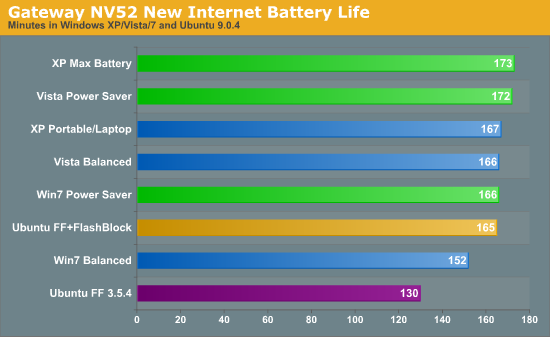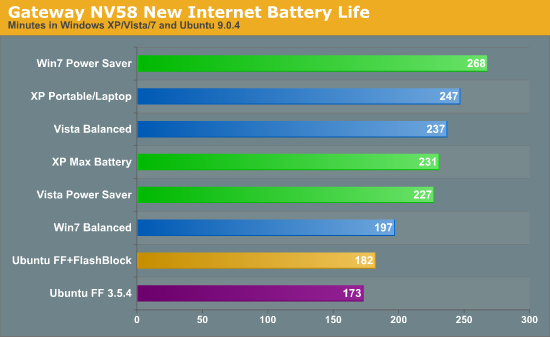Internet Battery Life, Round 2
We were a bit concerned with some of the Internet battery life results, so we decided to retest all of the systems using different websites. We felt that variance in the content of the webpages we used originally, even with repeated testing, might have skewed some of the results, so we switched to websites that present content more consistently. This time, we selected Yahoo!, MSN, the main YouTube page (no videos actually playing), and the Facebook login page (representing a simple web page, though logging in on Facebook makes it a lot more complex). The Yahoo! page is active while the other three are in tabs and their content is not visible. Here are the results for both systems.
[Drum roll…]


Okay, we're not finished yet, since we're still running some of these tests on the laptops. We'll update this page as we complete additional tests, so check back during the week. You can see what we mean when we say the results were inconsistent, however, as the placement of certain OSes is very different from our original Internet tests. On the NV52, all of the Balanced battery results are a lot closer to the Power Saver results this time, with the largest difference coming in Windows 7 at 9%. That isn't entirely out of sync with what we would expect, since Flash content may result in the CPU running at higher speeds without the limits imposed by Power Saver. However, Windows 7 suddenly drops to the back of the pack and we again have to question the results. [Queue yet another retest.] Ubuntu still shows a 27% boost in battery life by using FlashBlock, but that's less than the 44% boost shown originally. That makes sense, considering we aren't using sites with nearly as much Flash content. We will update the charts with Vista + Firefox results later this week and rerun the Windows 7 tests just to be safe.
The NV58 results aren't any better at clearing things up, since this time Windows 7 has a huge lead in its Power Saver result but trails by a significant amount in the Balanced test. So despite using sites that appear to be more consistent at first blush, we're afraid that there's still variability and we need to run more tests. Another interesting aspect is that Ubuntu hardly shows any difference between Firefox and Firefox + FlashBlock on the NV52, garnering a scant 5% increase in battery life. At least XP and Vista generate relatively consistent results, which is more in line with what we would expect. Of course, expectations are frequently wrong, which brings us to round three….










106 Comments
View All Comments
nortexoid - Wednesday, September 23, 2009 - link
I'd like to see a test done using "regular" office apps (openoffice, acrobat reader, etc.) and NO internet browsing. (Yes, that's how I use my computer off the plug usually.) It would weed out the performance usage hit taken by Ubuntu when flash is running.It might also be interesting to do a test with tweaked systems, e.g. by tuning Jaunty with PowerTop or similar apps. How does each OS perform when FULLY optimized for battery life (without sacrificing features or much performance, of course)?
7Enigma - Wednesday, September 23, 2009 - link
I know there are users (Jarred apparently you are one of them) that run a system without antivirus/spyware, but you are (or at least should be) in the minority. Linux distro's apparently can get away without it, but on ANY Windows box it's a MUST HAVE. Also disabling those other services (while good at reducing variables) again undermines the system's protection and comparisons to a general usage scenario.In your article I do not think you mentioned what you tweaked (but I could have overlooked this). From my initial impression when reading the article you took both OS' as they were default installed and then tested from there. I think you skewed the results badly in the favor of the Windows platforms by doing this, and I say this as a Windows-only user (never used Linux in any flavor). The first thing I do after a fresh install (still on Vista) is turn off all of those programs you did, along with a host of other services/eye candy using BlackViper's Vista Tweaks. This significantly speeds up the OS in all aspects but can hardly be considered most users configs.
At first reading these comments I was firmly on the "sour grapes" to all of the Linux users complaining about what distro was used, or why X wasn't tweaked by going to a website and reading a tech article, but now I kind of agree with them. Your experience with Windows and lack of experience with Ubuntu had you setting up one for failure before the first test was even run.
Either you test both OS' as they are default installed (driver incompatibilities aside), or you need to have a Linux semi-guru set up your Ubuntu box. My recommendation is the former, as the latter has so many variables it's probably not worth testing in the first place.
Aside from the Ubuntu portion I enjoyed the article. It was very interesting to see how the different power profiles jockeyed for position. I would like to second an earlier commment that asked for idle time to shutdown numbers. Let's be honest, most of us are not going to surf continuously from 100% to dead battery. Rather we are more likely to use the laptop for a bit and then walk away, and come back later. It also will give a good indication of those background tasks impact on battery life (if you don't disable them in your config). I have a sneaky suspicion XP might look very good as it seems to be quite a bit more bare-bones than Vista/7.
Thanks again.
code65536 - Tuesday, September 22, 2009 - link
An Intel engineer explained it some years ago in a blog posting: XP's max battery basically throttles the CPU's frequency down all the time. For example, on my Core2Duo, it'd mean that the CPU will operate at 800MHz all the time, even when it's busy. On the other hand, if Windows gives Speed Step a free hand and lets Speed Step determine the speed, then the CPU will operate at 2GHz when busy, and slow to 800MHz only when it's idling. According to this Intel engineer, it makes no sense to have it always throttled to 800MHz, because that means that tasks will take longer to finish, and the CPU will spend less time idling (which is when the CPU *really* saves power), and he labeled the max battery mode as the "what the hell are you doing?" mode.Drizzt321 - Tuesday, September 22, 2009 - link
I completely understand your complaints on the length of time required to run the test, plus recharge the battery. Have you considered buying a 2nd or 3rd battery and finding an external charger? Or would that kill the results of the test because the battery would be different?PepperPot2 - Tuesday, September 22, 2009 - link
I fail to believe you included the default grub time in the boot as this to do so would be unrepresentative of real use. Who would sit there and wait for it to time out rather than just press the enter key triggering the boot process? Anyway a default install of ubuntu (where it is the only OS on the machine) doesn't show the grub menu, only a 2 second alert to allow you to bring it up if you want. I then immediately boots.My experience with ubuntu is totally contrary to the conclusions you just posted about speed. We've have ~20 installs of Ubuntu 9.04 at work on old machines (7 yrs old) to a machine I built 1 month ago. In all instances the staff find it it is smoother and quicker to use than the dual boot copy of vista or XP.
The boot time on XP is clear nonsense, when ubuntu boots to the desktop you can use it almost immediately. XP is typically totally unusable for ~30 seconds while it loads more crap in the background. Vista is worse.
jasperjones - Tuesday, September 22, 2009 - link
That's true, XP and Vista are pretty unresponsive for a minute or so after boot on your average entry-level laptop. OTOH, Ubuntu is snappy once you see the GNOME desktop. 9.04 is called jaunty ducy ;)However, the same can be said of Win 7. It keeps loading stuff after you see the desktop, but that doesn't make the system feel sluggish--not at all
JarredWalton - Tuesday, September 22, 2009 - link
The Windows boot times are stopped when I see the default system try icons appear (WiFi connectivity, volume, etc.) so the system is pretty much usable at that point. As for GRUB, it's a 2 second timeout, which I could bypass by pressing enter twice, but that still leaves around 8 seconds from the POST to the point where it looks like Ubuntu is actually loading. What's going on during that time? If we subtract POST times, then Ubuntu would look even worse. I can see about tweaking GRUB to skip straight to loading the OS and see if that helps as well... when I get time.jasperjones - Tuesday, September 22, 2009 - link
FYI--one can simply configure GRUB to not wait for user input by editing /boot/grub/menu.lst and changing the second or third line from "timeout x" to "timeout 0"But I generally completely understand the argument not to change too many things from the default installation of Ubuntu, as it's doubtful that the average user would do it.
maveric7911 - Tuesday, September 22, 2009 - link
I would love to see a properly installed and setup distribution of linux in this review (not bashing love that you included linux at all). As others stated above Archlinux would be a pretty good choice. All packages come optimized and things like native 64bit flash and other native 64 bit applications are apart of the stable repository "no adding repos necessary". Also as mentioned, not using the hardware accelerated driver of ati or nvidia will take a big hit on power right away. I'm always available to assist with any linux testing and/or questions.HP
Sr Linux Engineer
andrewaggb - Tuesday, September 22, 2009 - link
What I would like to see is Jared run all the tests on his version of Ubuntu, then let a linux expert have some ssh love to tweak it all up, and then let Jared run the tests again and see how much difference he finds.